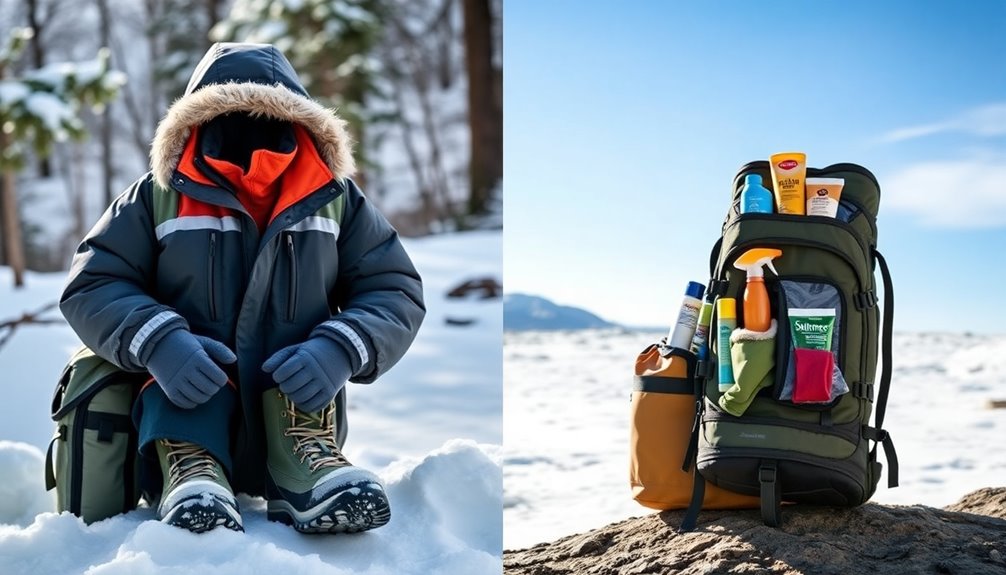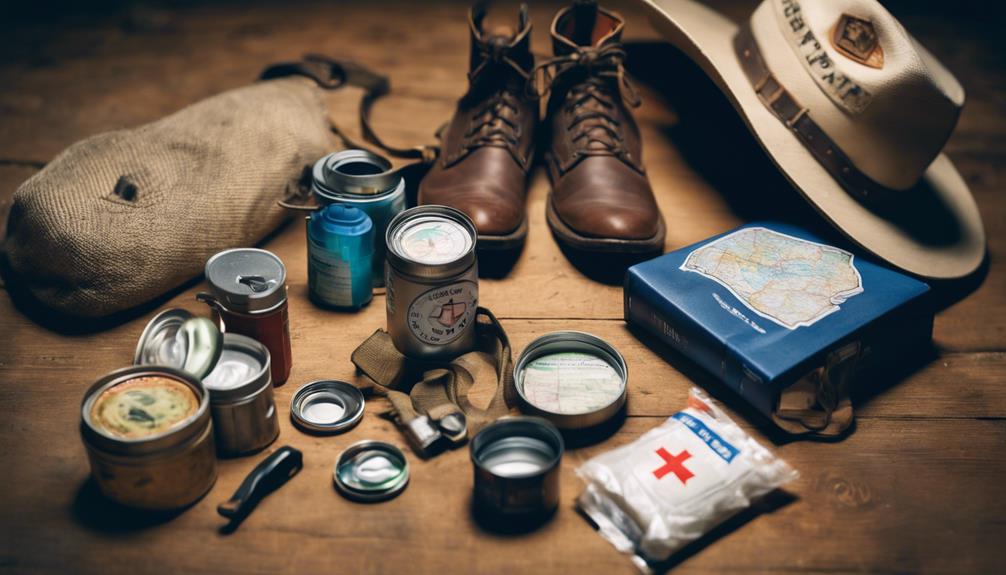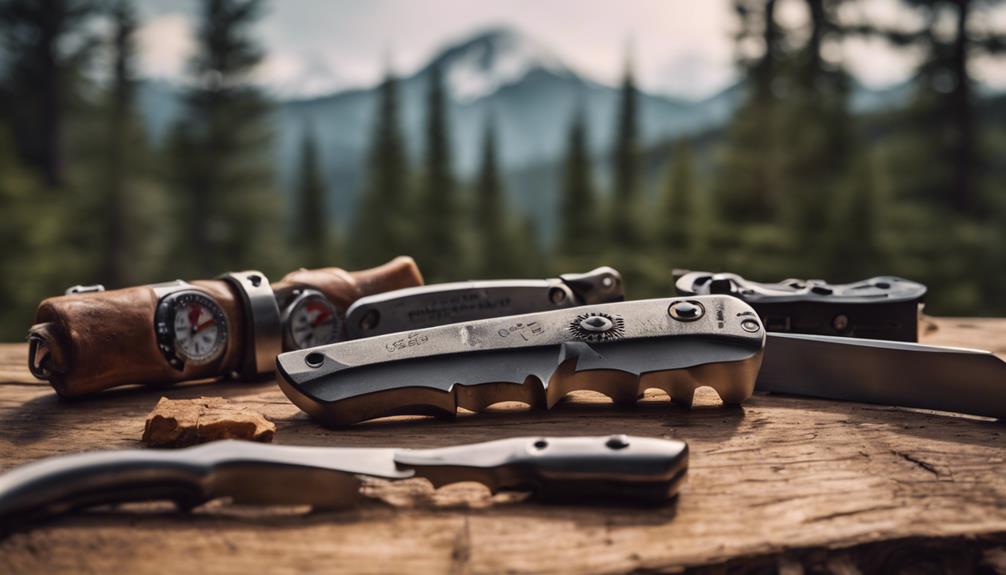When packing your Bug-Out Bag, you want to take into account your climate to stay safe and comfortable! For cold weather, include warm clothing, a cozy sleeping bag, and a portable stove. If it's hot, lightweight clothes, hydration packs, and wide-brimmed hats will help keep you cool. In wet conditions, pack waterproof gear like jackets and tents to keep everything dry. Don't forget that snacks and water purification tools are super important no matter where you are! Each climate has special needs, so make sure to customize your pack, and there's even more to explore about each climate's essentials ahead!
Key Takeaways
- Cold Weather: Include high-quality sleeping bags, moisture-wicking base layers, and insulated outer layers to withstand freezing temperatures.
- Hot Weather: Pack lightweight, breathable clothing and hydration packs to ensure adequate water intake in high temperatures.
- Wet Conditions: Essential gear includes waterproof clothing, high-quality tents, and tarps to keep equipment dry and safe from moisture.
- Hydration Supplies: Ensure a minimum of 6-9 liters of water, along with portable purification methods, to maintain safe hydration.
- Personalization: Tailor the Bug-Out Bag with climate-specific items and regularly update supplies to stay prepared for emergencies.
Understanding Bug-Out Bags

A Bug-Out Bag (BOB) is your lifeline in emergencies, packed with essential supplies for quick evacuation. Think of it as your very own survival kit! It's designed to help you stay safe and comfortable for at least 72 hours, or even up to a week, if you ever need to leave your home in a hurry.
When you create your Bug Out Bag, you'll want to include items that fit your personalized needs. For example, everyone faces different risks depending on where they live. So, you might need water purification systems, non-perishable food, first aid kits, and even multi-tools to help you out. Consider adding wood pellet stoves for efficient heating in cold climates, ensuring warmth and comfort during emergencies. Additionally, make sure to include waterproofing treatments to protect your gear from unexpected weather conditions. Remember that choosing the right heating solution can lead to increased efficiency and comfort in various climates. Furthermore, having a well-thought-out Bug-Out Bag can enhance your personal and community resilience during crises.
Don't forget to add shelter materials to keep you cozy! Including portable camping toilets can also enhance your comfort and hygiene in emergency situations.
It's also super important to check your Bug Out Bag regularly. Make sure all the items are working and up-to-date. This way, you'll always be ready for anything that comes your way!
Climate-Specific Essentials

Understanding climate-specific essentials for your Bug-Out Bag can greatly enhance your preparedness. You need to pack different items depending on the climate you'll face.
If you're in a hot climate, add lightweight, moisture-wicking clothing, a wide-brimmed hat for sun protection, and hydration packs to keep you cool and hydrated.
For wet climates, waterproof rain gear like a poncho is super important, along with a durable tarp to stay dry.
In snowy areas, don't forget snowshoes or crampons to help you walk easily through the snow, and a snow shovel to build shelters or clear paths.
If you're dealing with tropical climates, pack insect repellent and breathable fabrics to stay comfortable. Most importantly, bring a reliable water purification system to make sure you can safely drink water, avoiding any nasty germs. Additionally, always consider multi-functional gear to save space and weight in your pack.
And if you're preparing for cold weather, thermal clothing, insulated sleeping bags, and a portable camping stove are must-haves to stay warm.
Each climate has its needs, so think about these climate-specific essentials to make your Bug-Out Bag ready for anything!
Packing for Cold Weather

When temperatures drop, packing for cold weather becomes essential for your Bug-Out Bag. Start by choosing a high-quality sleeping bag rated for low temperatures, like a 20°F or lower bag. This will keep you warm during chilly nights!
Don't forget to layer your clothing. Pack moisture-wicking base layers to keep you dry, insulating mid-layers like fleece or down for warmth, and a waterproof and windproof outer layer to shield you from the elements. Proper diet is equally important to maintain energy levels during cold weather.
Insulated boots are a must! Pick sturdy footwear that has a good grip and waterproof features. They'll help keep your feet warm and dry, even in snowy or icy conditions.
Accessories matter too! Include a wool or synthetic hat, gloves, and warm socks since most body heat escapes through your head and extremities.
Lastly, add a compact, portable stove and fuel to your bag. Cooking hot meals and boiling water is crucial for keeping up your energy and staying hydrated in freezing temperatures. Additionally, consider incorporating energy-efficient heating systems into your emergency plans, as they can significantly reduce costs and improve comfort during extended stays in cold conditions.
With these essentials packed, you'll be ready to face the cold confidently and comfortably!
Preparing for Hot Environments

When you're getting ready for a hot adventure, it's super important to think about staying cool and hydrated!
You'll want to pack lightweight, breathable clothes that help keep you dry, along with plenty of water and a way to filter it. Additionally, consider the color accuracy of your outdoor gear, as it can help improve visibility in bright conditions. A nutritious breakfast option like an Egg Rollup and Dumpling Sauce can provide you with the energy needed for your activities. To enhance your outdoor experience, consider bringing along a portable device for merchant services to facilitate any on-the-go transactions you may need. It's also wise to include water filters in your packing list for safe drinking water.
Don't forget those fun extras like a big hat and some cool sunglasses to protect yourself from the sun while you explore! Additionally, maintaining high vibrational energy can enhance your overall experience and keep your spirits up during your outdoor activities.
Hydration Strategies and Supplies
Staying hydrated in hot environments is essential for your safety and well-being. You should carry a minimum of 2-3 liters of water per person per day. That means you'll need 6-9 liters for a bug-out bag designed for at least three days!
To save space, use collapsible water containers like Platypus bottles. They're lightweight and easy to pack, plus they can be flattened when empty. Additionally, it's wise to consider safety gear that can help you in emergencies, such as a first aid kit.
Don't forget about water purification! Purification tablets or a Sawyer Mini filter are great tools to guarantee you have safe drinking water during emergencies. This way, you can refill your hydration pack or containers without worry. A well-maintained hydration system can significantly improve your overall efficiency in emergency situations.
In hot weather, it's also smart to include electrolyte supplements or energy powders. These help replace minerals you lose through sweat, keeping you strong and healthy.
If you want easy access to water while you're on the move, consider a lightweight, insulated hydration bladder or Camelbak system. This way, you can sip water whenever you need, making sure you stay hydrated and ready for adventure! Additionally, it's important to regularly monitor your hydration levels to prevent dehydration risks that can arise in extreme temperatures.
Lightweight Clothing Recommendations
As you prepare for your bug-out bag, don't overlook the importance of lightweight clothing to keep you comfortable in hot environments. Choosing the right materials is key! Go for lightweight, moisture-wicking fabrics like polyester or nylon. These materials help keep your body cool and dry by allowing sweat to evaporate quickly. It's much better than cotton!
You'll also want long-sleeved shirts and pants. They protect your skin from sunburn, insects, and scratches while still letting air flow through. Plus, lightweight, breathable fabrics like merino wool can help regulate your body temperature. They're great for both hot days and cooler nights! Additionally, wearing lightweight clothing can help reduce the risk of sunburn and heat-related illnesses, as well as promote healthier skin appearance by minimizing UV exposure. Many glamping sites offer eco-friendly options that enhance your comfort while remaining sustainable. It's essential to ensure your clothing choices support moisture management to keep you dry and comfortable in the heat.
Don't forget a wide-brimmed hat! It'll shield your face and neck from the sun, and UV-protective sunglasses will keep your eyes safe.
For your feet, pack moisture-wicking, quick-drying socks and sturdy, breathable shoes. This will help prevent blisters and keep you comfy while hiking or walking for long periods.
Additionally, incorporating specific utensils like a water bottle can enhance your hydration strategy, ensuring you stay refreshed during your outdoor activities. Additionally, incorporating specific utensils like a water bottle can enhance your hydration strategy, ensuring you stay refreshed during your outdoor activities. Staying hydrated not only boosts your energy levels but also supports your body’s ability to function optimally in varying conditions. Pairing hydration with natural medicine cabinet essentials, such as herbal teas or portable remedies, can provide a holistic approach to maintaining your well-being while on the go. These small yet powerful additions can turn any adventure into a rejuvenating and health-conscious experience.
With these tips, you'll be ready for anything the heat throws your way. Happy packing!
Gear for Wet Conditions

When you're preparing for wet conditions, it's super important to pack the right gear!
You'll want waterproof clothing, like a durable rain jacket, to keep you dry and cozy. Additionally, it's wise to consider the drainage importance of your shelter to ensure that water doesn't accumulate around you. Also, having an effective filtration method for air quality can be crucial if you're stuck indoors for extended periods. Maintaining proper ventilation in your shelter will help prevent dangerous gas buildup, ensuring a safer environment. It's also beneficial to include water filters in your bug-out bag to ensure access to safe drinking water in wet conditions.
Plus, having a reliable shelter and ways to manage water will help you stay comfortable and safe, no matter how rainy it gets! Additionally, be sure to consider air quality indicators to monitor your environment, especially if you're in a confined space with limited ventilation.
Waterproof Clothing Requirements
Protection from the elements is essential in wet conditions, making waterproof clothing a must-have for your Bug-Out Bag. Staying dry helps you keep warm and prevents problems like hypothermia. For your adventure, pack a lightweight rain jacket and pants; they're easy to store and provide quick protection against rain and wind. Additionally, wearing air purifier technology can enhance your overall comfort by improving indoor air quality when you seek shelter from the rain. It's crucial to remember that exposure to moisture can exacerbate respiratory issues, especially in confined spaces.
Here's a quick guide to help you choose the right gear:
| Item | Description | Importance |
|---|---|---|
| Rain Jacket | Lightweight, breathable, packs easily | Protects from rain and wind |
| Waterproof Footwear | Hiking boots or shoes that repel water | Keeps feet dry and prevents blisters |
| Waterproof Poncho | Versatile for wearing or as shelter | Provides extra coverage and ground cover |
| Waterproof Gloves | Keeps hands dry and warm | Protects extremities from moisture |
Don't forget waterproof gloves and hats! They're super important for keeping your hands and head warm in rainy weather. With the right waterproof clothing, you'll be ready for anything nature throws your way. Sound therapy can also be beneficial in helping you relax and maintain focus during your adventure. Happy packing!
Essential Shelter Options
Staying dry and comfortable is essential in wet conditions, so having the right shelter options in your Bug-Out Bag can make all the difference.
First, consider a lightweight tarp. It provides waterproof coverage and can be quickly set up as a temporary shelter or rainfly. This makes it super versatile for different situations. Additionally, using a tarp can also help you create a temporary shelter in various environments. Many tiny house designs also emphasize space efficiency, which can inspire how you utilize a tarp effectively. A tarp can also be used to create multiple camping setups for varying weather conditions.
Next, a high-quality, waterproof tent is a great choice! Look for one with a durable rainfly to keep you dry during heavy rain, and ensure it is made with non-toxic materials to further enhance safety.
Don't forget about Mylar emergency blankets! They're compact and help you stay warm while blocking wind and moisture. In unexpected wet situations, they can be a lifesaver.
Another fantastic option is a bivvy sack. This waterproof and breathable shelter protects you from rain and wind, plus it's lightweight and easy to pack.
Lastly, waterproof bags or stuff sacks are vital for keeping your clothing and gear dry. They prevent water damage to important items like food and electronics. Additionally, incorporating energy-efficient water systems into your gear can help you manage water usage effectively in the wild.
With these shelter options, you'll be ready to tackle any wet conditions that come your way! Happy adventuring!
Effective Water Management Techniques
Effective water management is essential for survival in wet conditions, and having the right gear can greatly enhance your efforts. When you're out in the rain, you want to be ready!
Here are three must-have items for your bug-out bag:
- Durable nylon poncho: This not only keeps you dry but can also collect rainwater for drinking. How cool is that? Using a poncho can also help to lower your carbon footprint by reducing the need for additional waterproof gear. It's important to remember that assisted living expenses can add up if you don't plan for such conditions, especially when considering outdoor activities. In addition, being prepared with the right gear reflects the principles of self-reliance in survivalism. Additionally, a poncho can be used to create a makeshift shelter, providing protection from the elements during unexpected downpours.
- Moisture-wicking clothing: Wearing synthetic materials helps you stay warm and dry, as they won't soak up water like cotton.
- Lightweight, collapsible water storage: A Platypus collapsible bottle is perfect for carrying water when you find it, and it saves space when it's empty!
Don't forget to pack water purification methods, too! Bringing portable aqua tabs or a Sawyer Mini filter guarantees you can drink safely from streams or puddles.
Finally, a waterproof dry bag keeps your gear safe and organized, even in heavy rain. With these items, you'll be well-prepared and ready to tackle any wet adventure! Additionally, staying hydrated is crucial for maintaining energy efficiency during physically demanding situations.
Stay dry and enjoy your journey!
Arid Region Considerations

When you venture into arid regions, it's vital to adapt your bug-out bag to combat the unique challenges posed by intense heat and limited water sources. First, pack lightweight, moisture-wicking clothing to keep you cool and comfortable. Don't forget long sleeves and a wide-brimmed hat to protect you from the sun! Additionally, understanding the importance of preparation can significantly enhance your ability to cope with extreme environments. In these regions, climate change impacts can exacerbate water scarcity, making your hydration strategy even more critical. Investing in gold IRAs can also be a wise financial strategy for long-term stability while facing uncertain environments. Geothermal heat pumps, for instance, are an example of how using renewable energy sources can help mitigate the challenges faced in extreme climates.
A solid hydration strategy is fundamental. Carry at least 3-4 liters of water per person each day. Portable water purification methods, like a Sawyer Mini filter, will help guarantee you have safe drinking water wherever you go.
For your meals, include high-energy, non-perishable food options like energy bars, dried fruits, and nuts. These snacks give you the calories you need without weighing you down.
Shelter plays a big role too! A lightweight and reflective shelter is your best friend. Consider packing an emergency mylar blanket or a tarp to provide shade during the hot days and keep you warm at night.
Don't forget essential tools like a multi-tool for repairs and a lightweight sleeping pad to insulate from the hot ground. With these items in your bug-out bag, you'll be ready to tackle the challenges of arid regions! Additionally, integrating energy-efficient solutions in your emergency planning can help reduce your overall resource consumption.
Finalizing Your Bug-Out Bag

After addressing the unique needs for arid regions, it's time to finalize your bug-out bag. This is an exciting step that guarantees you're ready for anything!
First, check if you have all your Bug Out Bag Essentials. Make sure you've got climate-appropriate clothing to keep you comfy.
Here's a quick list to help you:
- Moisture-wicking layers for hot weather, keeping sweat away from your skin.
- Insulated gear for cold environments to keep you warm.
- A versatile sleeping system, like a compact sleeping bag that adapts to different temperatures.
Next, don't forget to regularly update your Bug-Out Bag! Check expiration dates on food, medications, and water purification supplies to make certain everything is safe and effective.
Personalize your bag by adding items that fit your local climate, such as waterproof gear for rainy areas or sun protection and hydration packs for dry regions. Keeping a checklist can help you easily manage your inventory.
With these steps, you'll have a well-prepared bug-out bag that's just right for you, no matter the emergency. Happy packing!
Frequently Asked Questions
What Should You Have in Your Bug Out Bag?
When you're packing your Bug Out Bag, think about the essentials you'll need to stay safe and comfy!
Start with water, snacks, and a first aid kit. You'll want a flashlight and extra batteries, too.
Don't forget a map and compass to help you find your way. A sturdy multi-tool can be super handy, and a warm blanket keeps you cozy.
With these items, you're ready for anything that comes your way!
What Is the Best Color for a Bug Out Bag?
You might think bright colors are the best for a bug-out bag, but they can attract unwanted attention!
Instead, go for earth tones like green, brown, or tan. These colors help you blend into nature, keeping you safe and discreet.
If you're near a forest, a dark bag works great!
Balance is key: you want to be hidden yet ready to signal for help if needed.
Choose wisely, and you'll be prepared!
How Many Days Should a Bug Out Bag Last?
Your Bug Out Bag should last at least three days!
That's about 72 hours of supplies to keep you safe and comfy in an emergency.
You'll want enough food and water to keep your energy up, so think about packing 6-9 quarts of water and snacks that give you lots of calories.
It's super important to check your bag regularly, making sure everything's fresh and ready for action!
What to Put in a 3 Day Survival Pack?
Did you know that staying hydrated is super important?
For a 3-day survival pack, you'll want to pack at least 3 liters of water and a way to purify it, like tablets or a filter.
Don't forget non-perishable snacks, like energy bars and jerky, to keep your energy up!
A compact first aid kit is essential, too, along with sturdy clothing and a flashlight.
These items will help you stay safe and healthy!
Conclusion
Now that you know the essentials for your bug-out bag, it's time to pack with excitement! Imagine the cozy warmth of a sleeping bag on a chilly night or the invigorating sip of water after a hot day. Whether you're facing snowflakes, sunshine, or rain, you can be ready for any adventure. So grab your bag, fill it with your special gear, and let's get outdoors! The world is waiting for you to explore!










